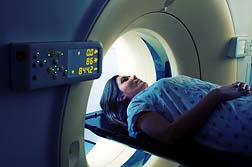 But there's even more to it than that, as there is another procedure that also uses gadolinium contrasting agents.
But there's even more to it than that, as there is another procedure that also uses gadolinium contrasting agents.Like MRI, or magnetic resonance imaging, MRA is a similar process that tracks the flow of blood through vessels. MRA, according to a posting on the Deaconess Health System web site, is an acronym for magnetic resonance angiography. Like MRI, MRA uses a powerful magnetic field and radio frequency waves combined with the injection of contrasting agents in order to provide doctors and technicians with the best image possible.
The problem for some is the contrasting agent. Gadolinium is a heavy metal that is not normally found in the human body. Thus, it can prove toxic in the human body if it is not eradicated by normal means—through the kidney and expelled as waste product.
For most healthy Americans, gadolinium is not a problem. The contrasting agent is injected in order to facilitate the series of scans required in the MRI / MRA imaging. Afterwards, the contrasting agent is excreted from the body naturally, over a period of about 24 hours.
It's when this doesn't happen that the troubles begin to mount. And for patients suffering from kidney disease or chronic kidney failure, the risk for Nephrogenic Systemic Fibrosis (NSF) or Nephrogenic Fibrosing Dermopathy (NFD) is very real unless the gadolinium is eradicated from the body through other means, notably dialysis.
NSF/NFD is a rare but debilitating condition that is characterized by a hardening of the skin, especially at the joints. This impedes movement and in extreme cases virtually entombs patients in their own skin. The key therefore is the eradication of the gadolinium from the body. For kidney patients, the implementation of dialysis immediately following MRI is crucial, but also somewhat of an assurance that the contrast agent will be eradicated from the body in an efficient manner.
For healthy people with healthy kidneys, it is assumed that gadolinium will be removed naturally and efficiently, thereby minimizing any risk for NSF/NFD.
It should also be noted that there are five gadolinium-based contrasting agents that carry approval by the US Food and Drug Administration (FDA) for MRI use.
However, what is often overlooked is that the five contrasting agents that do carry FDA approval for use in MRI, are not approved for use in MRA, "where the doses can be up to 3 times higher than for MRI," according to a talking head that appears on the August, 2006 edition of 'FDA Patient Safety News' currently floating around You Tube.
"These agents have been used off-label for MRA."
READ MORE MRI HEALTH RISKS LEGAL NEWS
Were a gadolinium-based contrast agent used for an MRA—a procedure which, according to the FDA video requires levels of contrast agent three times higher than that of an MRI—it would stand to reason that any associate risk for NSF/NFD could be three times higher.
Thus, it continues to be an important issue for both doctors and patients to be fully aware of MRI health risks and the potential for those risks in association with an MRI scan and pre-existing kidney failure. For patients already suffering from renal failure or weakened kidneys, gadolinium kidney failure and the associated adverse effects can be debilitating—and even more so with MRA.
